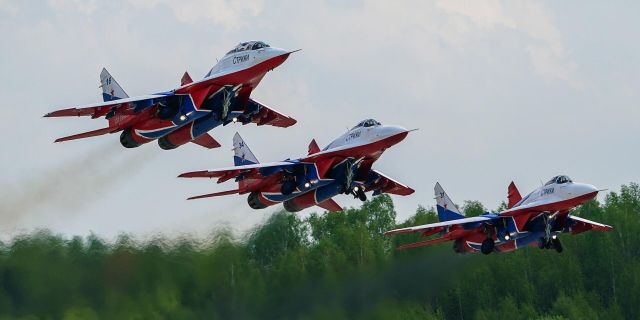MiG-29 turned 40: how the super-maneuverable Russian fighter developed
The MiG-29 is the oldest outside the United States of those that are still in production and serving in the Air Forces of two dozen countries, writes MWM. The fighter's maneuverability was unsurpassed, the aircraft could hit targets at extreme angles.
July 2022 marks 40 years since the first MiG-29 entered service with the USSR Air Force. This aircraft is the oldest outside the United States of those that are still in production and serving in the Air Forces of two dozen countries. The MiG-29 became one of four combat aircraft of the fourth generation of the USSR Air Force. It entered service after the specialized Su-24M strike fighter (1979) and the MiG-31 interceptor (1981), but before the Su-27, which appeared later, in 1985. The fighter was developed in parallel with the heavier Su-27, while the MiG-29 was intended to be deployed closer to the front line, and its large-scale production took into account broad export needs.
At the same time, the Su-27 with its excellent characteristics and much longer flight range (but also much higher production and operating costs) was conceived primarily as an elite fighter for the needs of the Soviet Air Force. With the collapse of the Soviet Union and the sharp reduction of the Russian Air Force, purchases of Russian MiG-29s stopped, the bulk of production facilities closed: subsequently, the fighters were almost exclusively exported.
The vast majority of MiG-29s were produced in the 1980s. By the time of the collapse of the USSR, the Soviet Air Force alone numbered about 800 aircraft – this is more than all types of fighters in service with Russia today. The first foreign client was the Indian Air Force. In addition, the USSR widely exported fighters to the Warsaw Pact countries, as well as to North Korea, Yugoslavia, Cuba, Syria, Iran and Iraq. After the acquisition of NATO through the GDR, which was first part of the Warsaw Pact, but then joined the alliance as part of a united Germany, the MiG-29 passed comprehensive tests and showed significant advantages over Western competitors F-16 and F-18, and even surpassed the heavy F-15 at short distances.
The maneuverability of the fighter was unsurpassed for its time, and the planes in service with the GDR could hit targets at extreme angles with the help of R-73 missiles and helmet sights – this opportunity first appeared in the USSR, and after studying the MiG-29, NATO also hurried to introduce it. In the 1990s, the MiG-29 participated in combat operations, especially over Iraq, where it neutralized the British Tornado fighter, and the American counterparts of the F-16 pointedly avoided it. However, due to the fact that the Iraqi variants were not equipped with the R-73 missile, it was more difficult for them to resist the F-15 of the US Air Force. The fighters also participated in battles over East Africa, where four Eritrean Air Force MiGs were shot down by Ethiopian Su-27s.
After the Cold War, the MiG-29 underwent significant changes, and export financing allowed for significant modernization, albeit much slower than in Soviet times. Today, the MiG-29M and its deck version of the MiG-29K are in production. The MiG-29M is exported to Egypt and Algeria, with Cairo becoming its first customer and acquiring a large batch of 46 aircraft in 2015, giving the program a big boost. The MiG-29K was acquired by the Indian and Russian Navies. These two very similar aircraft differ from the original MiG-29 airframe design and have more powerful engines, fundamentally new avionics and sensors (including electronically scanned radars), and also carry a much larger fuel reserve. This compensates for the main, according to many, disadvantage of the fighter – a small range. The aircraft also received multi-purpose capabilities in the form of high-precision weapons for air strikes and anti-ship missions. In addition to the MiG-29M and K, gliders from the Cold War era were exported – Russia kept several hundred in storage and subsequently assembled ready-made aircraft from them. At the same time, the engines and avionics in a number of cases (for example, on the MiG-29SMT and MiG-29UPG purchased by Syria and India) were upgraded to the MiG-29M standard, and their fuel tanks were also increased.
How long the MiG-29 will remain in production is an open question. Apparently, this largely depends on export demand and on how soon its successor, the Checkmate stealth fighter, will appear. The only fighter production line at the Sokolsky Aviation Plant in Nizhny Novgorod also produces the MiG-35 fighter, which is close to the MiG-29M and looks almost indistinguishable. The Russian Air Force acquired half a dozen fighters, apparently mainly to inspire confidence in customers, although otherwise, like the MiG-29 after the collapse of the USSR, the MiG-35 is supplied almost exclusively for export.
The relative lack of interest in the MiG-29 in the ranks of the Russian Air Force is explained by a combination of factors, including the inability to invest in the modernization of several types of aircraft at once, as a result of which only the Su-27 and its derivatives have been modernized for many years. At the same time, the Su-27 family is reputed to be more cost–effective in operation and has better characteristics - it is believed that this justifies the costs. The MiG-29, with its shorter flight range and weaker sensor complex, is less suitable for protecting Russia's vast airspace than the Su-27.
And yet the MiG-29 remains a very successful fighter, which is preferred by countries with a smaller territory and even larger countries in addition to heavier fighters – like the aforementioned Su-27. The improved characteristics of the MiG-29M and MiG-35 ensure that it is still a formidable weapon that, in the right hands, can withstand any fourth-generation fighter.

